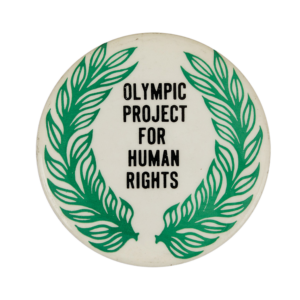How three world-class athletes set an example for us all in fighting racism in every arena of life
This iconic photo of Olympic sprinters Tommie Smith, John Carlos, and Peter Norman is one of the most famous protest images in history. Just like photographs of Tiananmen Square, Kent State, and Rosa Parks, these are striking visuals with which we are all too familiar but often unaware of the full story that led to these moments being captured on film.
The year 1968 is remembered as one of the most tumultuous in modern history. The Tet Offensive, the assassinations of Martin Luther King Jr. and Robert F. Kennedy Jr., and mass student protests worldwide with thousands of civilian casualties had all preceded the Mexico City Olympic Games in October.
 Meanwhile, American sociologist and civil rights activist Harry Edwards, PhD had founded the Olympic Project for Human Rights, an organization led by athletes to protest segregation in the United States and around the world and specifically segregation within sports. Initially, the group sought to boycott the ’68 Olympics entirely, if certain conditions weren’t met. Although the boycott largely failed, athletes who supported the OPHR continued to voice their messages of anti-racism and anti-segregation. Notably, the U.S. Olympic rowing team, comprised entirely of white Harvard students, wrote hundreds of handwritten letters to other members of the American Olympic delegation encouraging them to take a stand for racial justice. These actions resulted in an official censure from the U.S. Olympic Committee.
Meanwhile, American sociologist and civil rights activist Harry Edwards, PhD had founded the Olympic Project for Human Rights, an organization led by athletes to protest segregation in the United States and around the world and specifically segregation within sports. Initially, the group sought to boycott the ’68 Olympics entirely, if certain conditions weren’t met. Although the boycott largely failed, athletes who supported the OPHR continued to voice their messages of anti-racism and anti-segregation. Notably, the U.S. Olympic rowing team, comprised entirely of white Harvard students, wrote hundreds of handwritten letters to other members of the American Olympic delegation encouraging them to take a stand for racial justice. These actions resulted in an official censure from the U.S. Olympic Committee.
Following their record-shattering 200-meter race, Smith, Norman, and Carlos (gold, silver, and bronze, respectively) were to take their places on the dais for the medal ceremony. African American sprinters Tommie Smith and John Carlos had been discussing how they would use this moment to shed light on racial injustice and had decided on a few symbolic gestures: They were both shoeless as a symbol of black poverty, Smith wore a black scarf for black pride, and Carlos wore beads around his neck for those lynched and killed during slavery and Jim Crow. Lastly, they both wore the round OPHR button pinned to their tracksuits.
How can you ask someone to live in the world and not have something to say about injustice?” – John Carlos
Many often overlook that Australian silver-medalist Peter Norman is also wearing the OPHR button in solidarity. Norman was raised in a devout Salvation Army family and was an outspoken opponent of the White Australia movement. The button, which was banned by the International Olympic Committee, was given to him just before the ceremony by Paul Hoffman, a member of the U.S. rowing team.
All three went home to intense criticism for their actions in both the media and within professional athletic establishments but are ultimately remembered as pioneering figures who used the spotlight of athletic achievement to take a stand against racism. Smith and Carlos both received the Arthur Ashe Award at the 2008 ESPYs for advocating for equality in the face of adversity. In 2006, the U.S. Track and Field Federation proclaimed October 9, the day of his funeral, as “Peter Norman Day.”
These three men saw their athletic platform as not just as an opportunity but an obligation to take a stand against racism. Their example shows us that speaking up is not a responsibility to be held only by politicians and professional activists and that the fight for justice belongs to us all — regardless of color or nationality.
John Carlos has said, “How can you ask someone to live in the world and not have something to say about injustice?” That implores each of us to find our voice and use it to educate and advocate within our spheres of influence no matter the size. From humble kitchen tables to extravagant stadiums, the message that all men are created equal must be heard.
